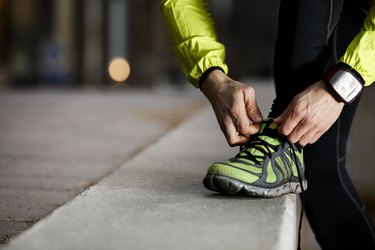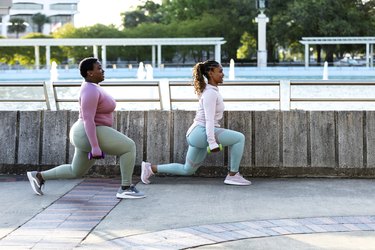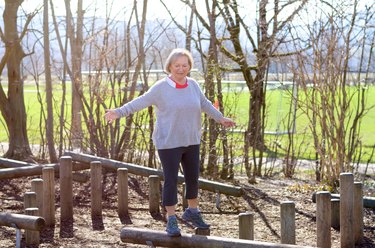
Learning to tie your shoes is a developmental milestone that comes with newfound independence and freedom. Finally, you can lace up and go — no assistance required.
So, it can be a little alarming when, after decades of managing your own double knots, bending down to tie a pair of sneakers becomes challenging or nearly impossible.
Video of the Day
Barring any problems with vision or finger dexterity, any inability to tie your shoes is likely due to a lack of flexibility, mobility, or balance. So, we asked Grayson Wickham, PT, DPT, CSCS, founder and head programmer at Movement Vault, to explain what might be happening with your body and how to fix it.
1. Your Hamstring Mobility Needs Work
Bending down to tie your shoes is an example of hip flexion, or drawing the knee toward the chest.
"Flexing at your hips is going to be dependent on the posterior side — aka the back side — of your hips, so primarily your hamstring mobility," Wickham says.
Mobility, he explains, is a two-part equation.
"It's really having the compliance in those muscles. So, are they flexible enough? And then, are you able to contract and control the muscles around your hip to move in a certain position?"
So, if you're not able to reach your feet or hold a bent-over position long enough to lace up, your lack of hamstring mobility may be to blame.
Fix It
To improve hamstring mobility, Wickham recommends a combination of self-myofascial release (aka foam rolling) and active stretching.
Hamstring Foam Rolling
- Sit on the floor and place a foam roller under your right hamstring. Extend your right leg, keeping your left knee bent and left foot on the floor.
- Lift your hips off the floor so that your weight is resting on the foam roller, the palms of your hands and your left foot.
- Roll your hamstring back and forth over the foam roller as you slowly rotate your leg. Spend more time on any spots that feel tight or “stuck.”
- Roll for 2 to 3 minutes before switching sides.
Active Hamstring Stretch
- Start in a low lunge position with your left foot in front and your right knee on the ground.
- Lean forward and place both palms on the ground inside your left foot.
- Push your hips back and extend your left leg.
- Once you feel a deep stretch in your hamstring, contract your hamstring by digging your left heel into the ground. Hold for 10 to 30 seconds.
- Repeat 3 to 4 times, resting between reps, before switching sides.
2. Your Lower Back Is Immobile
If you're working on your deadlift or even picking up something heavy from the floor, it's important to keep your back as flat as possible to protect your spine.
But, during an everyday movement like bending down to tie your shoes, a little spinal flexion is necessary. If you get stuck halfway to your toes, a rigid lower back may be to blame.
Fix It
The segmented cat-camel exercise is “gold” for anyone struggling with a stiff lower back, according to Wickham. Also known as “cat-cow,” this drill mobilizes your spine and activates your core musculature, which allows you to move into and hold a bent-over position.
Segmented Cat-Camel
- Start on all fours.
- Tip your pelvis forward and draw your navel toward your spine to round your back into a “cat” position.
- Slowly tilt your pelvis back and, one vertebrate at a time, starting with your lower back and ending with your neck, move your spine into an arched “camel” position. Hold for 5 seconds.
- Flexing your upper back first, gradually round your back one vertebrate at a time until you’ve transitioned back into a cat position. Hold for 5 seconds. That’s one rep.
- Complete 2 to 3 sets of 5 reps.
3. You Need to Stretch Your Calves
While your hamstrings and lower back are the most likely culprits, tight calves may also be a limiting factor in your ability to tie your shoes.
"The gastrocnemius — the bigger calf muscle — crosses the knee and the ankle. Having a tight gastrocnemius could potentially limit a bent-over or flexed position when your knees are straight," Wickham says. "Your soleus calf muscle, which only crosses your ankle joint, could limit your ankle dorsiflexion — drawing the toes toward the shin — when you have a bent knee, which could then limit your bent-over position."
Fix It
To loosen up your calves and improve their mobility, Wickham recommends doing an active calf stretch.
Active Calf Stretch
- Stand facing a chair, wall or other stable fixture, your feet about hip-width apart.
- Place your hands on the chair for stability and step back with your left leg.
- Bend your right knee and straighten your left leg, driving your left heel into the ground.
- Once you feel a stretch in the lower leg, contract the calf muscle. (Imagine you’re pushing down on a gas pedal.) Hold for 10 seconds, then release the contraction but stay in the stretch.
- Next, contract the muscles on the front of your ankle. (Think about pulling your foot off a gas pedal.) Hold for 20 seconds, then release the contraction and the stretch. That’s one rep.
- Complete 3 reps before switching sides.
4. You're Not Doing Enough Balance Training
Do you feel like you may tip over every time you attempt to tie your shoes — even with both feet on the floor? Then it's time to start incorporating balance training into your exercise routine.
In fact, even if you don't currently struggle with your sneakers, it's a good idea to proactively preserve your balance, which begins to decline rapidly in middle age. Researchers from a June 2022 study in the British Journal of Sports Medicine saw a correlation between the ability to stand on one leg for 10 seconds and a longer lifespan in adults ages 51 to 75.
Fix It
The 3-way toe tap exercise can be scaled according to your ability, Wickham explains. If you’re feeling wobbly, start slow and tap close to your standing foot. As your balance improves, you can begin to reach farther with each tap.
3-Way Toe Tap
- Stand with your feet hip-width apart, hands clasped in front of your chest.
- Shift your weight to your right foot and lift your left foot so it’s hovering above the ground. Bend your right knee slightly. This is the starting position.
- Tap your right toes about 6 inches (less if you’re a beginner, more if you’re advanced) directly in front of you and return to the starting position.
- Without resting your foot on the ground, tap your toes to the right, then return to the starting position.
- Tap your toes directly behind you, then return to the starting position.
- Perform the full circuit 10 times before switching sides. Complete 2 sets on each leg.
5. You’re Struggling With External Hip Rotation
What if your problem has nothing to do with bending over? Maybe you sit down to tie your shoes but have trouble lifting your ankle to rest it on top of the opposite knee.
If you're unable to bring your legs to this "figure four" position, you may have tight hip external rotators, which rotate your femur away from your body's midline.
Fix It
Work on getting into that cross-legged position with an active glute and piriformis stretch. Taking it to the floor allows you to make modifications and gradually amp up the intensity of the stretch.
Active Glute and Piriformis Stretch
- Lie on your back with your knees bent and feet flat on the floor.
- Lift your right foot and rest your right ankle on your left knee. (To lessen the intensity of the stretch, decrease the bend in your left knee by moving your left foot further away from your hips.)
- Draw your left knee toward your chest and reach for your left thigh with both hands. Place your hands on the back of your thigh just above your knee and pull your leg toward your chest, stretching your right hip. (If you’re unable to hold your leg, loop a strap or towel around your thigh and pull on either end.)
- Once you feel a deep stretch in your right hip, contract your hip external rotators by pushing your ankle into your thigh. Hold for 20 seconds, then release the contraction.
- Hold the stretch, repeating the muscle contraction for a total of 3 reps before switching sides.
6. It's Time to Change Your Shoes
In some cases, the path of least resistance makes the most sense. If tying your shoes just isn't in the cards (e.g., you're pregnant, dealing with an injury or have a disability), consider swapping your lace-up shoes for a pair of slip-on or hands-free kicks.
Our Favorite Slip-On Shoes
- Kizik Vegas Unisex Shoes ($129, Amazon.com)
- Kizik Unisex Lima Shoes ($109, Amazon.com)
- Merrell Embark Moc Shoe ($100, Merrell.com)
- Hush Puppies Elevate Bungee Shoe ($84.95, Hushpuppies.com)
Was this article helpful?
150 Characters Max
0/150
Thank you for sharing!
Thank you for your feedback!


